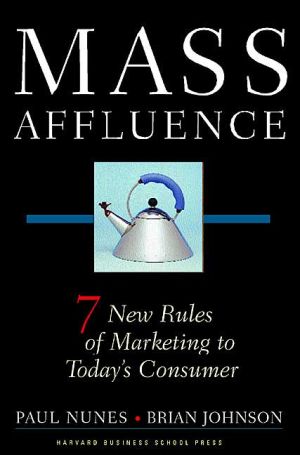Mass Affluence: Seven New Rules of Marketing to Today's Consumer
How to Capture Today's Biggest Untapped Market\ Forget mass customization and microsegmentation. Winning in today's business world requires a return to an approach abandoned by marketing experts decades ago. Mass marketing is back, say Paul Nunes and Brian Johnson-but with a new target and a fresh approach that companies ignore at their peril.\ While the mass-marketing concepts of the 1950s consisted of lowest-common-denominator strategies aimed at the "middle class," Nunes and Johnson argue...
Search in google:
Millions of consumers can now afford to pay more for everything from cleaning products to cars. Yet these "moneyed masses" are not spending all they could. Nunes, a researcher in business, and Johnson, a research analyst at an investment research and management firm, explore the impact of this explosion of consumer affluence on marketing strategy and practice, and outline seven new rules of mass marketing aimed at the "almost rich." Annotation ©2004 Book News, Inc., Portland, OR Journal Gazette When it comes to targeting affluent consumers (i.e. upper-middle class and above), this books is Mass Marketing 101.
1The new mass market1Pt. 1The new rules of positioning2Seize the new middle ground293Treat some customers more equal than others59Pt. 2The new rules of designing offerings4Find an occasional use855Introduce a new math of ownership1136Grow the return on consumption141Pt. 3The new rules of customer reach7Think global, retail local1678Become apropos of everyone191Pt. 4What next?9Tomorrow's mass market223Epilogue : reenvisioning an industry229
\ From The Critics"...lots of advice that marketers can sort through and apply."\ —The Globe & Mail\ \ \ \ \ Journal GazetteWhen it comes to targeting affluent consumers (i.e. upper-middle class and above), this books is Mass Marketing 101.\ \ \ The Washington PostIt's hard to imagine a business where these insights wouldn't be relevant.\ \ \ \ \ Publishers WeeklyDramatic shifts in the income of consumers in the U.S. will require a fresh approach by marketers, according to Nunes, a senior research fellow at Accenture's Institute for High Performance Business, and Johnson, a senior research analyst at the Sanford C. Bernstein investment firm. A new "mass market" has arisen as a result of the shift toward higher income residents, the authors believe. They describe a three-pronged effect: wealthier individuals are more important than ever to marketers; virtually every product from games to food is sold to people of a wide range of incomes; and the trends toward more spending concentrated in fewer households will require companies to consider the "keep up with the Joneses" factor. This carefully researched book explores a number of topics, like marketing, consumer habits and advertising. It is most clear when the authors discuss a well-known product or store, for example, the loyalty that has developed among Target shoppers or buyers of Lexus cars. The authors' "rules" are not complex, but the evidence used to explain them is specialized and detailed. The book will have practical applications for marketers and advertisers, but general business readers may find the presentation too technical. (Sept.) Copyright 2004 Reed Business Information.\ \ \ \ \ Soundview Executive Book SummariesIn Mass Affluence, customer management and marketing strategy experts Paul Nunes and Brian Johnson explain that we are witnessing a pendulum swing in marketing from "one-to-one" customer strategies back to mass marketing. But this is mass marketing with a twist: The targeted customers are not the middle class of the post-World War II era. They are richer yet more cautious consumers - and they won't respond to the strategies that worked with their middle-class predecessors.\ Based on extensive consumer research and practical application within many industries, Mass Affluence outlines seven new rules of mass marketing aimed directly at what Nunes and Johnson call the "moneyed masses." Throughout, the authors illustrate how innovative companies are already successfully implementing these strategies - not with traditional "luxury" goods, but with high-end products that fill an often ignored middle ground in ordinary categories from household cleaning to apparel to oral care.\ Exploring the marketing implications of this phenomenon for the first time, the authors reveal how organizations can capture the latent value in a powerful - and largely untapped - market.\ The New Mass Market\ While most companies have been busy trying to build one-on-one relationships with their customers, a number of businesses have been making startling amounts of money from offerings that don't "know" their individual buyers very well at all. These products and services are based on the interpretation of widely held needs and are not particularly concerned with their buyers' specific characteristics. In short, they are mass-market offerings.\ Procter & Gamble (P&G) has come back strong in the early 2000s from recent problems largely on the strength of a few new products. The company's July 2003 earnings report cited three examples of mass-market innovations instrumental in its return to success:\ \ Crest-branded whitening products, including Whitestrips and NightEffects, which helped grow a $50 million niche business in tooth whitening into a $750 million industry in just two years, with P&G grabbing 60 percent of that market.\ Swiffer mop, which pioneered the $900 million global surface-cleaning-system category, a category that virtually didn't exist as recently as 1997, and of which P&G now owns 60 percent.\ Olay skin care products, including Regenerist, a product that captured nearly a 10th of the facial moisturizer market in its first three months, and which, combined with Total Effects, gave P&G a 12-share gain in the category in a single year.\ \ \ \ \ New Offerings With Mass Appeal\ The phenomenon of producing successful new offerings with mass appeal is not limited to consumer products. Purchase categories from housing to restaurants to clothing retailers to lifestyle purveyors have all seen their fortunes grow over the years by serving millions of diverse consumers with essentially the same product. New mass-market categories are emerging as well; they're poised to grow quickly and their range includes everything from car sharing to shared personal chefs.\ The companies that are meeting with success have altered their strategies to serve today's mass market - a market very different from the one that inspired the first mass-marketing movement. These companies understand that the principles of mass marketing as they knew them no longer apply. They know this because they recognize three major changes that dramatically affect the way in which today's customer must be courted.\ Three Major Changes in Spending\ First, today's consumers, en masse, are far more affluent in terms of wealth and income than their predecessors. This is particularly true for a certain segment of upper-income, but not extravagantly rich, households.\ Second, consumer spending patterns have changed, despite the increase in affluence. One change is a drastic reduction in per-dollar-of-income spending in the households that have the most. This pullback represents a tremendous challenge for marketers, but also an unprecedented opportunity for those with the right offerings.\ Finally, consumers now want more options for spending their growing affluence, beyond traditional luxury offerings. In many cases, offerings perceived as lavish or luxury goods are being rejected outright. Affluent spending is no longer synonymous with luxury spending, and while some companies may achieve a measure of immediate success by shifting to a luxury-goods mentality, that success is unlikely to be broad based or long-lived.\ The mass market has changed and continues to change; the rules of marketing must also change if they are to successfully capture today's mass market. Copyright © 2005 Soundview Executive Book Summaries\ \ \








